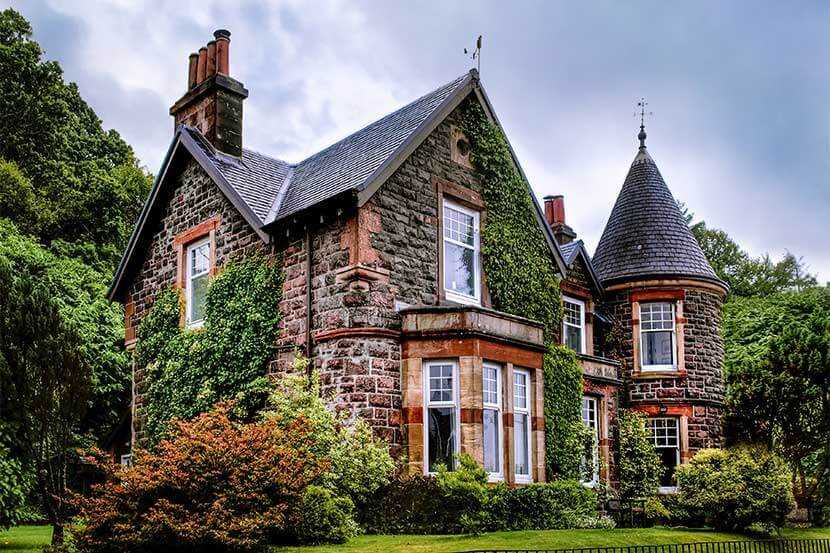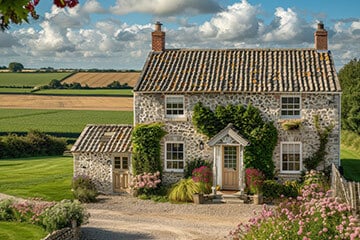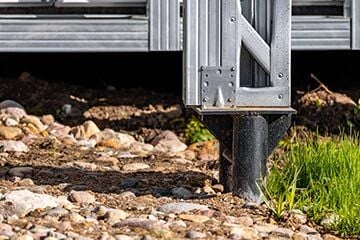There are many things that can impact the cost of your home insurance. The age of your house is one of them.
Working out the age of your house can turn out to be quite tricky, especially if it's an older property.
Here's what you need to know.

Key takeaways
- You can find out when your house was built by checking your title deeds, Land Registry record, or local council archives.
- If those don’t show the date, look for EPCs, historic maps, or ask previous owners.
- Knowing your home’s age helps you get accurate home insurance quotes and spot potential structural issues.
- Older homes may cost more to insure because they’re often built with materials that are harder to replace.
How do I find out when my house was built?
Wondering when your house was built? Our 'when was my house built?' tool provides a quick and straightforward way to find out. Simply pop in your postcode, and let the tool do the detective work.
You can find out when your house was built by checking its 'title register' or 'title deeds'. This document serves as proof of ownership and can also provide you with details about the home.
If you aren't able to get this, you should contact HM Land Registry. They hold records of land ownership in England and Wales, but not necessarily what’s been built there.
That said, it’s worth using the HM Land Registry search tool to find out what the resource knows about your property, especially if it’s not too old.
You can buy copies of title registers or plans for £3 each.
How accurate is 'year built' data?
While the data provided by HM Land Registry is likely accurate, it may not have all the information you need. If your home was built before 1940, it may be harder to work out exactly when it was built.
If your home is a new build, the data should be as accurate as you can get the information straight from the property's developer.
The Land Registry doesn't know when my house was built. How do I find it?
To give you a rough idea, Confused.com data shows that the most common house build dates are*:
| House build decade | Percentage of home insurance quotes |
|---|---|
|
1920s
|
19.9%
|
|
1960s
|
16.8%
|
|
1900s
|
16.7%
|
|
1980s
|
8%
|
|
Pre 1900s
|
7%
|
Here are some other methods that can help you:
Previous owners and neighbours
Ask the previous owners whether they’ve any survey results or other information that pinpoints when the property was built. If you can't speak to them, your neighbours might be able to help you narrow your search.
Listed building registers.
If you've been told the property is a listed building, it should be easy to verify its age via online search tools covering England, Northern Ireland, Scotland and Wales.
Maps
Ordnance Surveys, fire insurance and local authority maps may identify your home or road. Historical maps could narrow down the time period when the property was built. Fire insurance maps of urban areas are available at the British Library.
Census data
For a small fee, you can view property information from the regular 10-year census from as far back as 1841. This should help you narrow your search to a 10-year window. For more information, visit The National Archives.
What’s classified as an old house?
There's no official definition, but houses tend to be considered ‘old’ if they were built before 1940. These houses are typically referred to in relation to the period in history they were built.
Here are some typical features of houses in each period of history. Being able to spot these features might help narrow your search:
Tudor (1485 – 1603)
- Typically constructed from timber and brick
- The upper floor often juts out over the ground floor
- Windows tend to be small, as glass was an expensive commodity
Jacobean (1604 – 1713)
- Flat-fronted, bare brick properties
- Steep, gabled roofs
- Hints of gothic-style windows and doors
Georgian (1714 – 1820)
- Tall, rectangular sash windows
- Symmetrical, central front door
- Large fireplaces that dominate rooms
Victorian (1837 – 1901)
- Well-built, coloured brickwork properties with sloping roofs
- Bay windows
- High ceilings
Edwardian (1901 – 1914)
- Broader than the taller Victorian-era houses
- Hipped roofs with dormer windows
- Wide halls and dual-aspect rooms
Post WW1 (1918-1939)
- Simplified design
- Bare brick or pebble-dashed semi-detached family homes
- Large bay windows
Why is it helpful to know when my house was built?
It’s important to know when your home was built because:
- Its history could dictate whether you’d be able to make alterations
- It could impact how much you pay for your home insurance
For example, if you live in a listed building, you may face strict regulations when repairing damage caused by storms, flooding or even wear and tear.
You may need to find specific materials, such as bricks of the right type, age and colour. It’s better to know this upfront, rather than pay for amendments only to be ordered to remove it at a later date.
Knowing the age of your property is also important if you need to replace or repair structural elements of the home. For example, repairing period roof tiles.
Are older properties more expensive to insure?
Yes - in general, older homes are more expensive to insure.
"Older properties tend to be more expensive to insure because they aren't built to modern standards and so there's a greater risk of something going wrong. For example, old houses and listed buildings often have non-standard construction, like timber frames and thatched roofs. This makes them more at risk of fire damage.
"Add to that the fact that older houses also come with older wiring, plumbing and build quality. This means they're a higher risk of making a claim, and there's a greater chance that claim will be more expensive."
What our home & lifestyle insurance expert says

Here are the average buildings insurance costs depending on the age of the property, according to Confused.com data*:
| Age of property | Average buildings insurance cost* |
|---|---|
|
Before 1900
|
£447.04 |
|
1900s
|
£262.97 |
|
1910s
|
£275 |
|
1920s
|
£251.14 |
|
1930s
|
£238.25 |
|
1940s
|
£209.32 |
|
1950s
|
£222.17 |
|
1960s
|
£209.55 |
|
1970s
|
£220.91 |
|
1980s
|
£213.41 |
|
1990s
|
£231.43 |
|
2000s
|
£220.50 |
|
2010s
|
£181
|
|
2020s
|
£155.83
|
Compare home insurance quotes
*Confused.com data. Oct 2023 - Sep 2025. Buildings insurance policies only.








